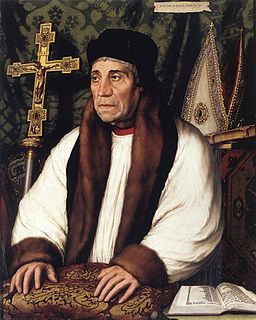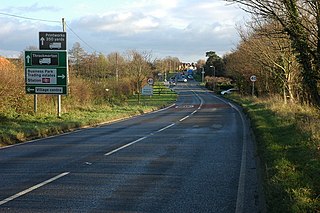Related Research Articles

William Tyndale was an English biblical scholar and linguist who became a leading figure in the Protestant Reformation in the years leading up to his execution. He is well known as a translator of the Bible into English, and was influenced by the works of prominent Protestant Reformers such as Martin Luther.

Thomas Boleyn, Earl of Wiltshire, 1st Earl of Ormond, 1st Viscount RochfordKGKB, of Hever Castle in Kent, was an English diplomat and politician who was the father of Anne Boleyn, the second wife of King Henry VIII, and was thus the maternal grandfather of Queen Elizabeth I. By Henry VIII he was made a knight of the Garter in 1523 and was elevated to the peerage as Viscount Rochford in 1525 and in 1529 was further ennobled as Earl of Wiltshire and Earl of Ormond.

William Warham was the Archbishop of Canterbury from 1503 to his death.

Sir Anthony St Leger, KG, of Ulcombe and Leeds Castle in Kent, was an English politician and Lord Deputy of Ireland during the Tudor period.
John Lambert was an English Protestant martyr burnt to death on 22 November 1538 at Smithfield, London.
William John Hamilton was a British geologist who served as a Conservative Member of Parliament.

Viscount Cobham is a title in the Peerage of Great Britain that was created in 1718. Owing to its special remainder, the title has passed through several families. Since 1889, it has been held by members of the Lyttelton family.

Baron Stafford, referring to the town of Stafford, is a title that has been created several times in the Peerage of England. In the 14th century, the barons of the first creation were made earls. Those of the fifth creation, in the 17th century, became first viscounts and then earls. Since 1913, the title has been held by the Fitzherbert family.

Baron Sudeley is a title that has been created thrice in British history, twice in the Peerage of England and once in the Peerage of the United Kingdom. The first creation came in the Peerage of England in 1299 when John de Sudeley was summoned to Parliament as Lord Sudeley. On the death of the third Baron in 1367 the title fell into abeyance. The abeyance was terminated in 1380 when Thomas Boteler, the fourth Baron, became sole heir. The sixth Baron was created Baron Sudeley by letters patent in 1441. He served as Lord High Treasurer from 1444 to 1447. On his death in 1473 the 1441 creation became extinct while the 1299 creation once again fell into abeyance.

John Frith was an English Protestant priest, writer, and martyr.
Viscount Tracy, of Rathcoole in the County of Dublin, was a title in the Peerage of Ireland. It was created on 12 January 1643 for Sir John Tracy, previously Member of Parliament for Gloucestershire. He was made Baron Tracy, of Rathcoole in the County of Dublin, at the same time, also in the Peerage of Ireland. The second Viscount also represented Gloucestershire in Parliament. The titles are considered to have become extinct on the death of the eighth Viscount in 1797. However, the peerages were the subjects of at least four claims presented to the House of Lords during the 19th century.
Events from the 1530s in England.
Stephen Vaughan (1502-1549) was an English merchant, royal agent and diplomat, and supporter of the Protestant Reformation.
James Bainham was an English lawyer and Protestant reformer who was burned as a heretic in 1532.
John Cottisford was an English churchman and academic, Rector of Lincoln College, Oxford, from 1518.
Richard Tracy was an English lay Protestant reformer and Member of Parliament.
Dr Richard Gwent was a senior ecclesiastical jurist, pluralist cleric and administrator through the period of the Dissolution of the Monasteries under Henry VIII. Of south Welsh origins, as a Doctor of both laws in the University of Oxford he rose swiftly to become Dean of the Arches and Archdeacon of London and of Brecon, and later of Huntingdon. He became an important figure in the operations of Thomas Cromwell, was a witness to Thomas Cranmer's private protestation on becoming Archbishop of Canterbury, and was Cranmer's Commissary and legal draftsman. He was an advocate on behalf of Katherine of Aragon in the proceedings against her, and helped to deliver the decree of annulment against Anne of Cleves.
Robert Tracy (1655–1735) was an English judge.
John London, DCL was Warden of New College, Oxford, and a prominent figure in the Dissolution of the Monasteries during the reign of Henry VIII of England.

William Neville of Penwyn and Wyke Sapie, Worcestershire, was the son of Richard Neville, 2nd Baron Latimer, and the author of The Castell of Pleasure. In 1532 he was accused of treason and dabbling in magic.
References
 This article incorporates text from a publication now in the public domain : "Tracy, Richard". Dictionary of National Biography . London: Smith, Elder & Co. 1885–1900.
This article incorporates text from a publication now in the public domain : "Tracy, Richard". Dictionary of National Biography . London: Smith, Elder & Co. 1885–1900.